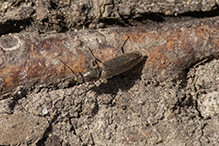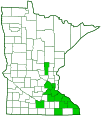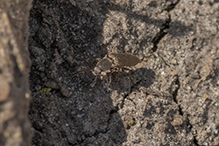cylindrical click beetle
(Sylvanelater cylindriformis)
Conservation • Description • Habitat • Ecology • Distribution • Taxonomy
|
|
||||||||||||||
Description |
Cylindrical click beetle is a very common, early season, click beetle. It occurs in the United States from Maine to Maryland, west to Minnesota and Iowa, and south along the Appalachian Mountains to virginia. It also occurs in southern Canada from Nova Scotia to Ontario. It is often abundant where it occurs. Adults are active from mid-March to early June, but mostly in April and May. They are found in deciduous and coniferous forests. The body is glossy brownish black, elongate, almost parallel sided when viewed from above, and convex when viewed from the front. The surface is finely to moderately pitted (punctate), and it is densely covered with moderately long, pale, ashy gray or brownish hairs. The antennae are reddish at the base, and they are moderately saw-toothed. They have 11 segments, and they are attached near the eyes. On the male they are long, with the last 2 to 4 segments reaching beyond the rear of the plate covering the first segment of the thorax (pronotum). On the female, they are shorter, reaching just to the middle of the pronotum. There is no separate plate on the front of the face (clypeus), but the upper part of the mouth (labrum), corresponding to the upper lip, is distinct. The pronotum is longer than wide and somewhat flattened, slightly to moderately convex when viewed from the front. The rear corners are extended into long, sharp, backward-pointing angles. The surface is densely punctured, and there are shallow longitudinal grooves in the rear. The small plate between the wing bases (scutellum) is visible and five sided. The hardened wing covers (elytra) are long, entirely covering the abdomen. They are broadly rounded at the rear. The inner margin is often reddish. The surface is narrowly and sharply grooved longitudinally. The spaces between the grooves are flat to slightly convex, and they are densely but shallowly punctured. The legs are reddish. The last part of each leg (tarsus), corresponding to the foot, has 5 segments. |
Size |
|
Similar Species |
Habitat |
Deciduous and coniferous forests |
Ecology |
Season |
April and May |
Behavior |
They are active during the day but will also come to lights at night. |
Life Cycle |
|
Larva Food |
|
Adult Food |
|
Distribution |
||
|
Sources |
|
| 5/13/2024 | ||
Occurrence |
||
Common |
||
Taxonomy |
|
Order |
Coleoptera (Beetles) |
Suborder |
Polyphaga (Water, Rove, Scarab, Long-horned, Leaf, and Snout Beetles) |
Infraorder |
Elateriformia |
Superfamily |
Elateroidea (Click, Firefly, and Soldier Beetles) |
Family |
Elateridae (click beetles) |
Subfamily |
Dendrometrinae |
Tribe |
Prosternini |
Genus |
Sylvanelater |
Subordinate Taxa |
|
|
|
Synonyms |
|
Ctenicera cylindriformis Elater cylindriformis Limonius cylindriformis |
|
Common Names |
|
cylindrical click beetle |
|
Glossary
Clypeus
On insects, a hardened plate on the face above the upper lip (labrum).
Elytra
The hardened or leathery forewings of beetles used to protect the fragile hindwings, which are used for flying. Singular: elytron.
Labrum
The upper part of the mouth, sometimes considered the lower part of the face, corresponding to the upper lip, on an insect or crustacean.
Pronotum
The exoskeletal plate on the upper side of the first segment of the thorax of an insect.
Punctate
Dotted with pits (punctures), translucent sunken glands, or colored spots of pigment.
Scutellum
The exoskeletal plate covering the rearward (posterior) part of the middle segment of the thorax in some insects. In Coleoptera, Hemiptera, and Homoptera, the dorsal, often triangular plate behind the pronotum and between the bases of the front wings. In Diptera, the exoskeletal plate between the abdomen and the thorax.
Tarsus
On insects, the last two to five subdivisions of the leg, attached to the tibia; the foot. On spiders, the last segment of the leg. Plural: tarsi.
Visitor Photos |
||
Share your photo of this insect. |
||
This button not working for you? |
||
Greg Watson |
||
 |
||
MinnesotaSeasons.com Photos |
||
|
||
|

Slideshows |
|

Visitor Videos |
||
Share your video of this insect. |
||
This button not working for you? |
||
|
Other Videos |
||
A Cylindrical Click Beetle (Sylvanelater cylindriformis) |
About
May 26, 2023 |

|
Created: 5/13/2024 Last Updated: © MinnesotaSeasons.com. All rights reserved. |



